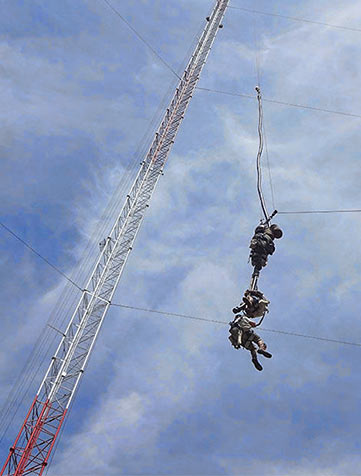Riding the line, when done properly, can be the safest method of ascending or descending a tower, but some industry workers continue to flout the current riding the line instruction that took safety stakeholders  almost 19 years to get OSHA to agree to a compliance directive (CPL) that made sense.
almost 19 years to get OSHA to agree to a compliance directive (CPL) that made sense.
The picture at right, which could pass for a sepia-toned “what we did in the day” photograph of reckless abandonment, was taken recently to complement an article about KOSU’s (107.5 FM) requirement to replace 70 feet of feed line near the 950-foot level of their Tulsa, Okla. guyed tower.
The NPR station’s article pointed out that it was 107 degrees F. when the men were riding the line, but the author had no idea that the danger wasn’t the heat, but with non-compliance by the tower climbers with OSHA CPL 02-01-056 that could have easily caused the men to fall.
It is unknown whether the rigging and other requirements were being met for an engineered hoist system for personnel lifting, and if a trial lift and proof testing was performed, but it is obvious that the crew is riding a load line since the 70-foot piece of transmission line is clearly attached to their line.
OSHA and the National Association of Tower Erectors spent over three years establishing an OSHA directive on how to ride the line safely in 1999. In 2002 it was revised and in 2014 the most recent CPL was issued.
The CPL, in part, states: “Hoisting personnel and materials concurrently: When using a personnel platform, small, incidental materials and personal tools may be hoisted concurrently with personnel in a manner consistent with 29 CFR 1926.1431(f). When a boatswain chair or boatswain chair-type full body harness is used, hoist personnel and materials separately.”
Although there have been no fatalities attributed to non-compliance with the CPL, it does not mean the industry is following the stringent guidelines required in the 21-page document, as witnessed during this installation.
The crew’s company’s management has been made aware of the violations.















